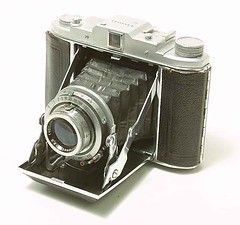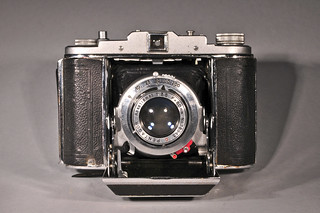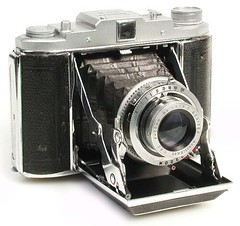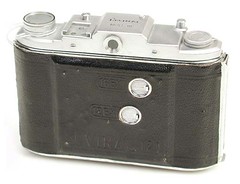Ruvinal
See also the Ruvinalflex 6×6 TLR.
The Ruvinal (ルビナル) is a Japanese dual-format 6×6 and 4.5×6 folding camera, made between about 1950 and 1955.
Contents
Origin
The Ruvinal was a continuation of the National and Ugein folders, made until the end of the war by Tōa Kōki. The body was inherited from the original model dated 1937. The top housing and other controls were inherited from the dual-format Ugein, released in 1943.
The Ruvinal is usually attributed to Shōei Kōgaku or Shōei Sangyō, but no original document has yet been found to confirm this.[1]
The camera was first distributed by Maki Shōji, successor of Eikōdō, the distributor of the National and Ugein before 1945. The name of the company became Eikōdō again in 1953.
Description
 
|
| Ruvinal, NKS shutter, Ruvinal Anastigmat 80mm f/3.5 lens (reported). Pictures courtesy of Pacific Rim Camera. (Image rights) |
The Ruvinal is a horizontal folder, with folding struts inspired from the Balda folders. There is a top housing covering all the top plate, containing the finder in the middle, this top housing is the same as on the Ugein. The body release is on the right, the accessory shoe and folding bed release are to the left of the viewfinder. The advance knob is at the left end and is bigger than on the Ugein. It has an arrow to indicate the winding direction and three letters engraved, perhaps reading R.O.M. There is a swinging mask in the viewfinder for 4.5×6 pictures, actioned by a small button on the top, absent on the Ugein.
The back is hinged to the left and has two round red windows, protected by horizontally sliding covers, slightly different from the Ugein. There are 16 EX and 12 EX indications embossed in the leather on the left of the windows. The name RUVINAL 120 is also embossed the back leather under the red windows. It is said that the camera can take 120 and 620 film.[2]
Advertisements and other documents
Some sources say that the Ruvinal was released in 1950.[3] A camera called Ugein Six (ユーゲンシックス) was featured in the December 1949 issue of the Japanese magazine Camera Art, with a Wester 75/3.5 lens and T, B, 1–200 speeds.[4] This was probably the name originally intended for the Ruvinal.
The earliest advertisement found in Japanese magazines is in the November 1951 issue of Asahi Camera.[5] The camera is simply called Ruvinal and has a coated 80/3.5 lens and a synchronized NKK Wester shutter, giving B, 1–200 speeds with a self-timer.
The camera was featured in the December 1951 issue of Asahi Camera as the Ruvinal III.[6] Advertisements dated December 1951 and later have a Ruvinal A with 1–200 speeds and a Ruvinal B with 10–200 speeds.[7] Both have a 80/3.5 lens, a self-timer and flash synchronization.
In advertisements dated May 1953, November 1953 and September 1954, the specifications are the same and the pictures show a R.V.L. shutter.[8]
Actual examples
One example is pictured in McKeown as a Ruvikon 120. It has a Wester Anastigmat lens and an NKK Wester shutter of an early type, giving T, B, 1–200 speeds with no flash synchronization.[9] This version probably predates the Ruvinal.

|
| NKS shutter, two-pin synch, Ruvinal Anastigmat 80mm f/3.5 lens (reported). Picture courtesy of Pacific Rim Camera.(Image rights) |
On the early examples of the Ruvinal, the name RUVINAL is engraved above the viewfinder together with the serial number. The following lens and shutter combinations are known:
- C Wester Anastigmat 7.5cm f/3.5 lens, N.K.K. Wester shutter (B, 1–200, self-timer, one-pin synch);[10]
- Ruvinal Anastigmat 80mm f/3.5 lens, N.K.K. Wester shutter (B, 1–200, self-timer, one-pin synch);[11]
- Ruvinal Anastigmat 80mm f/3.5, NKS shutter (B, 1–200, self-timer, two-pin synch);[12]
- Ruviner 7.5cm f/3.5, Lotus shutter (reported only).[13]
Lotus shutters are also found on the Gelto.
Ruvinal III
On the later examples, the top plate is engraved RUVINAL MOD. III, even if it seems that the camera was never advertised as the Ruvinal III. (McKeown mentions a Ruvinal II but its existence is unconfirmed.)[14] No other change is visible: the company probably felt that the name "MOD. III" added to the value of the camera. It is probably for a similar reason that a MODEL III engraving was added to the Ruvinalflex TLR, again with no model II and no apparent change.

|
 
|
| Ruvinal III with Pentagor Anastigmat 1:3.5 F=80mm image by Dirk HR Spennemann (Image rights) |
Ruvinal III, Model-A shutter (reported), C Seriter Anastigmat 75mm f/3.5 lens no.7773. Pictures courtesy of Scott at www.collectiblecameras.com. (Image rights) |

|
| Ruvinal III, N.K.K. Wester shutter, C Wester NKK 7.5cm f/3.5 lens no.28795. Picture courtesy of Scott at www.collectiblecameras.com. (Image rights) |
The following lens and shutter combinations are known for the Ruvinal III:
- C Pentagor Anastigmat 80mm f/3.5 lens set in
- Seriter Anastigmat 75mm f/3.5 lens set in
- C Seriter Anastigmat 75mm f/3.5 lens set in
- Model-A shutter (B, 1–200, self-timer, one-pin synch);[23]
- C. Wester NKK 7.5cm f/3.5 lens set in
- N.K.K. Wester shutter (B, 1–200, self-timer, one-pin synch).[24]
The R.V.L., Model-A and Model-B shutters have their respective name engraved at the base of the speed rim. The Carl Mer-A shutter is inscribed CARL MER-A at the top of the shutter plate (the name might be "Carlmer-A" as well). The Model-III shutter is inscribed MODEL-III at the bottom of the shutter plate, a similar shutter has been observed on a Gelto.
Rangefinder version
Further development led to the introduction of uncoupled rangefinder versions.
Ruvinal R
An uncoupled rangefinder version with lever advance, called Ruvinal R, was featured in the news column of the November 1955 issue of Sankei Camera.[25] Another source mentions the 1955 uncoupled rangefinder version but calls it "R.L.L. II".[26]
Ruvinal IV
The Ruvinal Mod. IV is a horizontal folder for 120 film.[27] There is a top housing covering all the top plate, containing the uncoupled rangefinder, the advance mechanism on the left and the RF focus wheel at the right. The body release is on the right side, above the RF wheel. The coincident rangefinder is uncoupled, meaning that the distance has to be read from a curved window on the top cover, and then transferred to the lens. The advance mechanism is by means of a folding lever, a clever detail not found on many folders. It has no auto stop, and frame alignment is by way of the red window in the back. The accessory flash shoe is centered. There are no side strap fittings. The camera has a tripod screw fitting underneath, in the centre.
The Ruvinal IV is a dual-format camera, capable of providing either 16 6x4.5 or 12 6x6 shots per roll of film. The back door has two windows to accommodate for each format, with sliding covers. There are 16 EX and 12 EX indications embossed in the leather on the left of the windows. The name RUVINAL 120 is also embossed on the back leather under the red windows.
Known examples
The two earlier units documented have a C. Pentagor 80/3.5 lens on RCK 1-200 + B shutter.[28] The late unit documented has the same lens on a 1-200 + B NKS shutter. Lens is front element focusing, multicoated, and closes up to f/22.
There is no serial number embossed or engraved on the leather. However, based on the lens serial numbers on the three units observed so far (and supposing these were not mounted on other cameras), it can be estimated a production of about 22.000 cameras. Earliest camera known has S/N 40346, while the latest has S/N 62292.
Notes
- ↑ Shōei Kōgaku: Kokusan kamera no rekishi, p.373. Shōei Sangyō: McKeown, p.891, Supuringu kamera de ikou, p.113, and Lewis, p.73. Sugiyama, items 1414–5, says "Shoei Manufacturing Co."
- ↑ McKeown, p.891.
- ↑ Supuringu kamera de ikou, p.113, and Lewis, p.73.
- ↑ Kokusan kamera no rekishi, p.371.
- ↑ Advertisement reproduced in Kokusan kamera no rekishi, p.209. It is the earliest advertisement listed in Kokusan kamera no rekishi, p.373.
- ↑ Kokusan kamera no rekishi, p.373.
- ↑ Date: Kokusan kamera no rekishi, p.373. Lewis, p.83, says that the "Ruvinal Six A and B" were introduced in 1953, but it is probably a mistake.
- ↑ Advertisements published in Asahi Camera, reproduced in Kokusan kamera no rekishi, pp.209–10. See also the advertisement dated 1954 reproduced in this page at Shashin-Bako.
- ↑ McKeown, p.891.
- ↑ Examples observed in online auctions. —s/n 7086 with Wester Anastigmat s/n 18085 [Worthpoint']
- ↑ Example pictured in Supuringu kamera de ikou, p.113.
- ↑ Example pictured in this page, the lens name Ruvinal is reported only. The example pictured as a "Ruvinal III" in McKeown, p.891, looks the same, with an NKS shutter and a similar lens bezel, and seems to have the early engraving type with the serial number.
- ↑ Example offered for sale by a dealer, reported as a "Ruvinal I".
- ↑ McKeown, p.891.
- ↑ Example pictured in Sugiyama, item 1415.
- ↑ Example sold in an online auction.
- ↑ Example sold in an online auction.
- ↑ Example observed in an online auction, and example pictured in this page of the Mokomoko Nikki blog (archived).
- ↑ Ruvinal III with C Pentagor Anastigmat f/3.5 80mm (s/n 38943) Photo Dirk Spennemann.
- ↑ Example pictured in a website, currently offline.
- ↑ Example pictured in Sugiyama, item 1414.
- ↑ Example sold in an online auction.
- ↑ Example pictured in this page, the shutter name is reported only.
- ↑ Example sold in an online auction and example pictured in this page.
- ↑ Kokusan kamera no rekishi, p.373.
- ↑ Supuringu kamera de ikou, p.113.
- ↑ Three examples have been documented, with Pentagor S/N 40346, 40364 and 62292
- ↑ C. Pentagor 80/3.5 s/n 40346 IV in RCK shutter (B, 1-200) (eBay May 2013).
Bibliography
- Asahi Camera (アサヒカメラ) editorial staff. Shōwa 10–40nen kōkoku ni miru kokusan kamera no rekishi (昭和10–40年広告にみる国産カメラの歴史, Japanese camera history as seen in advertisements, 1935–1965). Tokyo: Asahi Shinbunsha, 1994. ISBN 4-02-330312-7. Items 974, 1022–4 and 1028. (See also the advertisements for items 1025–7.)
- Kawamata Masataku (川又正卓). Ruvinal 120. In Supuringu kamera de ikou: Zen 69 kishu no shōkai to tsukaikata (スプリングカメラでいこう: 全69機種の紹介と使い方, Let's try spring cameras: The use of and actual examples from 69 machines). Tokyo: Shashinkogyo Syuppan-sha, 2004. ISBN 4-87956-072-3. P.113.
- Lewis, Gordon, ed. The History of the Japanese Camera. Rochester, N.Y.: George Eastman House, International Museum of Photography & Film, 1991. ISBN 0-935398-17-1 (paper), 0-935398-16-3 (hard). Pp.73 and 83 (brief mentions only).
- McKeown, James M. and Joan C. McKeown's Price Guide to Antique and Classic Cameras, 12th Edition, 2005-2006. USA, Centennial Photo Service, 2004. ISBN 0-931838-40-1 (hardcover). ISBN 0-931838-41-X (softcover). P.891.
- Sugiyama, Kōichi (杉山浩一); Naoi, Hiroaki (直井浩明); Bullock, John R. The Collector's Guide to Japanese Cameras. 国産カメラ図鑑 (Kokusan kamera zukan). Tokyo: Asahi Sonorama, 1985. ISBN 4-257-03187-5. Items 1414–5.
Links
In Japanese:
- Ruvinal III at the Mokomoko Nikki blog (archived)
- Advertisement for the Ruvinal and Ruvinalflex dated 1954, reproduced in Shashin-Bako
